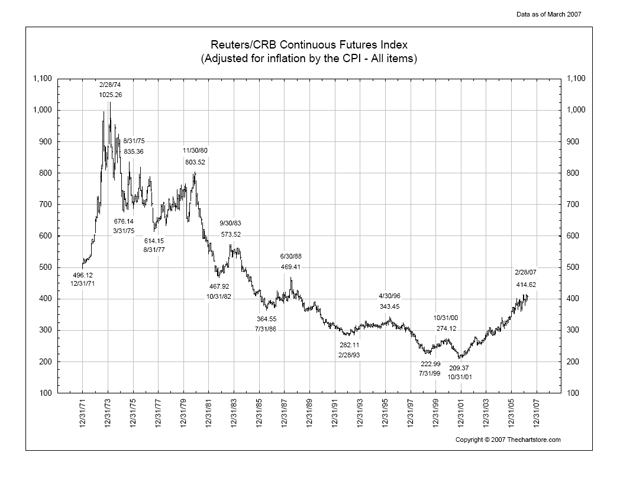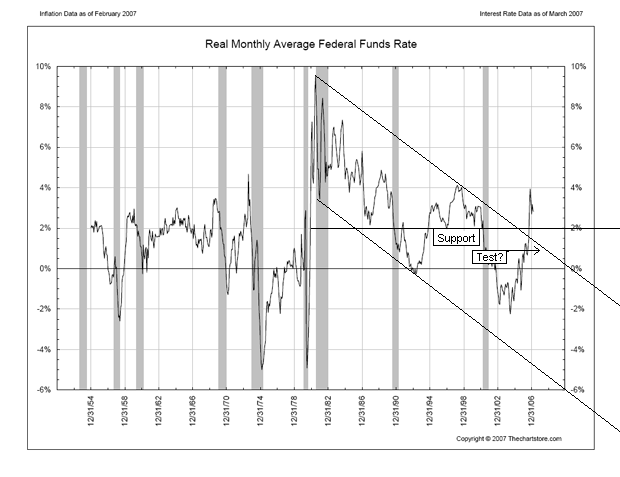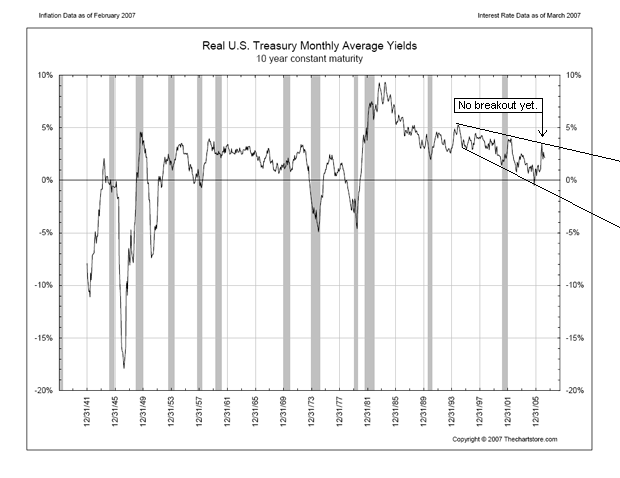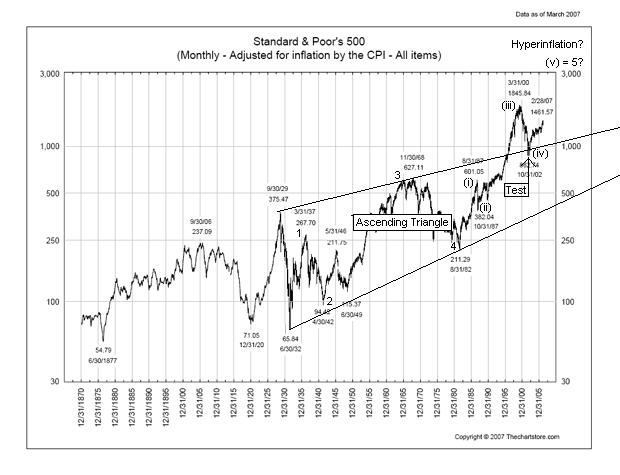First Comes Denial – And Then Acceptance
Economics / Liquidity Bubble Apr 24, 2007 - 09:03 PM GMTBy: Captain_Hook
Below is an excerpt from a commentary that originally appeared at Treasure Chests for the benefit of subscribers on Tuesday, April 10, 2007
It's no secret markets are dramatically affected by investor psychology. And it's also no secret the right investor psychology can cause prices to soar with a healthy liquidity backdrop, as was the case with both the tech bubble in 2000, and in real estate more recently. In fact, given participation rates in both of these bubbles was so high, it would not be a stretch to categorize them as manias in the truest sense of the word.
Be that as it may, little doubt exits they are the two most prominent ‘popped bubbles' the world has witnessed within more recent history. At the same time however, it should also be understood more important bubbles have yet to pop, like the larger credit bubble, even though subprime problems in the States suggest we are seeing the initial stages of implosion here too.
Now you may be asking yourself, ‘but isn't it all over once the Super-Cycle credit bubble pops?' And then, ‘don't we get deflation when this occurs, defined as contracting credit and money supply?' In answering these questions, for both instances a resounding ‘yes' is obvious. But, as you know from our more recent musings on this subject matter in chronicling progression of the various cycles real time, not before the liquidity cycle has also exhausted itself as well.
Little understood by most, and not easily differentiated by even the educated, you should know there is a difference between the credit and liquidity cycles, where just because credit cycle growth rates may be slowing down, this does not mean the monetary base will necessarily be rolling over just yet. As you know from our last outing , first you get stagflation , which is what we have now, and then an acceleration of the liquidity cycle into hyperinflation , which is what gold, is increasingly sensing each passing day.
As you may know in this regard, gold is pushing higher in discounting the ‘need for speed' in money supply growth rates to compensate for an increasingly weak economic backdrop. Here, and despite the erroneously robust employment report on Friday, which one must realize is an estimate by less than scrupulous government sources, the economy is definitely showing signs of increasingly broad weakness as measured not just by the housing market, but by broader indicators, such as durable goods and factory orders . And as mentioned previously, this weakness is set against rising prices, both at the wholesale and retail levels, which is the definition of stagflation set against generous doses of monetary largesse . Of course not many have noticed this yet, or believe it, which is why gold is not shooting higher at the moment. Here, we have all read about this kind of thing happening previously, but it could not be happening today – could it?
And even less people want to contemplate what's coming down the pike as stagflation matures, that being hyperinflation. Why is hyperinflation necessary to keep the economy rolling? Answer: Because western economies, with special attention paid to the US , have essentially exported the bulk of their manufacturing to Asia , leaving domestic economies ‘hollowed out' in terms of regenerative growth capabilities, devoid of multipliers in relying increasingly on service sectors. So, when the economy slows, and because savings are low combined with debts being high, money must be printed on an accelerating basis in order to prevent general activity levels from imploding.
What's worse, western economies have become increasingly dependent on an expanding credit bubble , which as mentioned above is in jeopardy of rolling over quite soon. Right now, lost growth in real estate related loans is being replaced by increasingly large private equity and leveraged buyout deals. This too shall pass however, and when it does the feds will be forced to replace associated money supply growth from here with money from helicopters , or hyperinflation. And if you think people are in denial about stagflation, just wait until the hyperinflation picture matures a bit. Sure, gold might hesitate again just prior to a ‘moon shot', but once the investing population accepts what they would first prefer to avoid if possible, shoot higher it will. Of course you can't blame them for attempting to avoid such thoughts, as we all know what comes after hyperinflation, that being what could be termed an acceleration of the Kondratieff Winter .
In his latest , Peter Schiff does a good job of showing where the investing population is right now in terms of sentiment in this regard. Here, although he does not mention the ‘s' word, that being stagflation, he notes the slowing economy. What's more telling in terms of denial that is gripping the investing public at present however is his comment associated with the possibility of hyperinflation. Here, he leaves his readers (and himself) hoping the Fed finally decides to show some restraint. How he could go down this road is beyond me knowing their proclivities, but here are his comments anyway, as follows:
"However, it is important to point out that as a collapse in consumer spending ushers in a recession, the Fed will not have the luxury of lowering interest rates to cushion the fall. Despite surging unemployment, “inflation” will only accelerate, as extreme dollar weakness abroad translates into higher consumer prices at home. In addition, long-term interest rates will be headed higher as well, as foreign savers look to be compensated for this loss of purchasing power. Higher interest rates and substantial increases in the cost of living will only exacerbate the housing downturn and the recession, turning what would normally have been simply a severe recession into something far worse.
Although this may sound like a sobering scenario, it is definitely not the worst case. The real doomsday would only come as a result of Fed-created hyper-inflation which could be used to pump up all varieties of falling asset prices. Let's hope the boys at the Fed decide not to go there.”
So, in my mind this is why gold has been held back, because of this denial, but once it's more readily accepted both stagflation and hyperinflation are in the cards, this should change, with the next significant hurdle being the $750 mark as per historical milestones shown in the first chart attached here . What's more, it should also be understood that once the acceptance stage is reached in the larger investing population, no amount of manipulation will be able to hold it back as investor greed (and fear of hyperinflation) kick in – nothing. And with good reason of course, where when one takes a good look at just how much inflation has occurred over the past 40 years set against real gains in general commodity prices, one may come to realize the explosion nominal prices could see into the future in order to reflect this largesse. (See Figure 1)
Figure 1

As you can see above, in terms of historical precedent commodity prices are just rounding the corner higher in reflecting not only past inflation, but also discounting more into the future. And while some would say the Fed would never allow such a thing to happen today (more denial by neocon types), these people should be reminded central bankers are not solution here, but the cause. Sure the Fed attempts to show the market it's responsible through what appears to be hawkish policy, where at present real rates utilizing official inflation data makes it appear they are slamming on the brakes to fight inflation. And that's the ‘party line' right now, where rising inflation is still the Fed's ‘chief concern' . (See Figure 2)
Figure 2

But again, as you know from last week , actual price gains in the larger economy are some multiple above official figures, where if put against nominal bank rates would paint a different picture entirely, one of the ‘easy money' environment that still exists today. A good example of this is the structural disparity between short rates, pictured above, and long rates, the market rates utilized to set mortgages, pictured below. More naturally if either the market or authorities were really serious about slowing inflation 10 – year rates would escape sinusoidal resistance. But of course their action do not match their words, where any ‘tough talk' out of the Fed these days is just more ‘wag the dog' rhetoric designed to keep the feeble minded confused. (See Figure 3)
Figure 3

Here one should notice that while short rates have undergone a structural break higher in an attempt to cool input prices, some how magically (think monetization) long rates remain structurally confined within a range that by some accounts will ensure recovery from here, a re-inflation of the real estate bubble and refi-loan ATM machine if you will. You see people that understand this liquidity will be provided also know the housing slump will dissipate as we enter next year, which would lift the entire economy just in time for the election, albeit ever-increasing amounts of liquidity will be required to accomplish such a feat since multipliers are weakening with services becoming almost the ‘whole enchilada' these days. More of that stagflation thingy – you know?
So, what have we learned here? Well, for starters, right now we have stagflation, which should lead into hyperinflation as process unfolds over the next few years. And in further summarizing the above, it should be obvious at this point that despite official policy and statistics designed to fool the masses into thinking inflation is under control, nothing could be further from the truth. In the first place, one must differentiate between inflation, which is the creation of new money by monetary authorities, from price increases, which is in fact the result of said inflation. Past this, and in knowing what one must do in order to protect yourself from the lies, and inflation (and then rising prices that naturally follow), it should also be understood in relation to the above that monetary officials have gotten so good at their craft (providing ample liquidity to keep the larger bubble economy inflated) they are able to stay well ahead of any covert ploys (hawkish policy or gestures) designed to manage prices lower at various times.
And again, this means in spite of what may seem ‘responsible policy' by officials to curb what they call inflation, you should recognize this, along with acting to protect yourself by grounding portfolios in ‘real assets' that hedge against the paper related debasement of our economies. Not surprisingly, this logic extends to the stock market as well, because when it comes to escaping inflation, and as the mania in this regard extends, it should be remembered investors are creatures of habit. Stocks are quick and cheap to trade, and you do not need safe storage like physical gold and silver, which accounts for the growth in all varieties of ETF's, but especially those focusing on precious metals. Of course some would argue with all the fraud out there stocks are becoming more hazardous in this regard, meaning stock certificates should be obtained, but we will leave this topic for another day. Be that as it may, the real S&P 500 (SPX) looks like it has further gains in the cards from here based on the count (unless fifth wave failure), which of course also means nominal gains should be expected as well. So, on this basis it appears the ability to inflate is still alive and well. (See Figure 4)
Figure 4

Of course with short positions down dramatically over the past week, along with monetizations, as measured by M3 growth rates , we will likely get a test of the larger trend once supportive index related put options expire in two weeks. Volumes have been contracting in this most recent rally in the broad markets, along with other indicators suggesting caution should be observed at this point, where a great number of traders are looking for a test of the highs before stocks head lower in earnest. If history is a good guide however, this should bring short sellers back into the market with the first sign of trouble, so yet again, we will pass on this apparent shorting opportunity as well. If volumes pick back up after tax time, which essentially ends next Monday with the deadline Tuesday, things could look different by options expiry if we see a little correction now however, so we will keep you posted in this regard.
In referring back to the above, its understandable monetizations (M3 growth) have been in decline considering M2 and MZM growth rates have doubled over the last month, meaning monetizations are not necessary. What's more, it should be pointed out the US money supply is currently enjoying a more natural double - digit inflation rate, meaning money is being brought into existence through credit expansion, with private equity deals the big contributors of late, as mentioned above. And even though this cannot last forever, it implies monetary authorities are not about to play the hyperinflation card (accelerating monetizations) just yet, further evidencing gold is still cheap in this regard. This is why it keeps bouncing back no matter how much price mangers try to slap it down, like yesterday. Easter Monday is always a low volume day, which is a perfect opportunity to slap both the metals, and larger commodity complex (especially crude oil), down without spending a great deal of paper. Naturally the test comes the next day when volumes pick back up, where I see gold is already giving price mangers a headache this morning. Here's hoping they have a migraine by noon for the sake of our juniors that are being sold by nonbelievers.
In my opinion, and in addition to the points made last week concerning underperformance on the part of precious metals juniors as gold / silver continue to grind higher, clearly this occurrence also has a great deal to do with the primary subject matter under discussion here today, that being denial and disbelief inflation still has a healthy future ahead. Anybody who has been through a bear market in precious metals holding onto a few juniors know just how painful such an experience can be, many of which going under during such times. So, it's natural for investors to attempt to stay well ahead of the curve if they see trouble brewing, which many apparently see these days evidenced by severe under-performance of the larger group against the metals. We of course are opposite in our view, where it is recommended one both sit with existing positions through such times, as well as accumulate well considered positions that fit within your portfolio parameters.
Of course the flip-side of the coin is that if these fears prove unfounded, and that as with the case presented above, gold and silver in fact have bright futures directly ahead, these same investors will be quick to return to the market, snapping prices higher to the point of euphoria in the end. What's more, it's the fact we are nowhere near such a euphoria at present, along with the knowledge inflation is accelerating, which as you should know is good for gold, is all the more reason to be bullish on juniors (and the sector at large), because in the end the larger sequence will not be complete until this occurs if history is a good guide. Like all manias, a condition that should grip precious metals once wide acceptance by the masses is found, in the end, gains in these shares should be absolutely breath taking. And it's this prospect that makes them worth holding, even though it's the larger and more liquid producers that will do better until this acceptance of the bull market in precious metals is fully grasped by the larger investing population.
With respect to the larger shares then, it appears they have broken out against the metal as measured by the Amex Gold Bugs Index (HUI) / Gold Ratio in having closed above the 200-day moving average for three days now, testing this support yesterday with the Easter Monday smack down. What we would like to see now is perhaps a bit more testing, followed by the HUI running through triple – top (and rectangle) related resistance at 362 initially in coming days, followed by gold plowing through $680, and then the large round number at $700 on it's way to $765, the preliminary point & figure (P&F) target. And I must say things look promising in this respect as prices continue to notch their way higher up the ‘wall of worry'.
If this is the kind of analysis you are looking for, we invite you to visit our new and improved web site and discover more about how our service can further aid you in achieving your financial goals. For your information, our new site includes such improvements as automated subscriptions, improvements to trend identifying / professionally annotated charts , to the more detailed quote pages exclusively designed for independent investors who like to stay on top of things. Here, in addition to improving our advisory service, our aim is to also provide a resource center, one where you have access to well presented ‘key' information concerning the markets we cover.
And if you have any questions, comments, or criticisms regarding the above, please feel free to drop us a line . We very much enjoy hearing from you on these matters.
Good investing all.
By Captain Hook
Special Note: Charts provided courtesy of The Chart Store.
Treasure Chests is a market timing service specializing in value-based position trading in the precious metals and equity markets with an orientation geared to identifying intermediate-term swing trading opportunities. Specific opportunities are identified utilizing a combination of fundamental, technical, and inter-market analysis. This style of investing has proven very successful for wealthy and sophisticated investors, as it reduces risk and enhances returns when the methodology is applied effectively. Those interested in discovering more about how the strategies described above can enhance your wealth should visit our web site at Treasure Chests
Disclaimer: The above is a matter of opinion and is not intended as investment advice. Information and analysis above are derived from sources and utilizing methods believed reliable, but we cannot accept responsibility for any trading losses you may incur as a result of this analysis. Comments within the text should not be construed as specific recommendations to buy or sell securities. Individuals should consult with their broker and personal financial advisors before engaging in any trading activities, as we are not registered brokers or advisors. Certain statements included herein may constitute "forward-looking statements" with the meaning of certain securities legislative measures. Such forward-looking statements involve known and unknown risks, uncertainties and other factors that may cause the actual results, performance or achievements of the above mentioned companies, and / or industry results, to be materially different from any future results, performance or achievements expressed or implied by such forward-looking statements. Do your own due diligence.
Copyright © 2007 treasurechests.info Inc. All rights reserved.
Unless otherwise indicated, all materials on these pages are copyrighted by treasurechests.info Inc. No part of these pages, either text or image may be used for any purpose other than personal use. Therefore, reproduction, modification, storage in a retrieval system or retransmission, in any form or by any means, electronic, mechanical or otherwise, for reasons other than personal use, is strictly prohibited without prior written permission.
© 2005-2022 http://www.MarketOracle.co.uk - The Market Oracle is a FREE Daily Financial Markets Analysis & Forecasting online publication.



